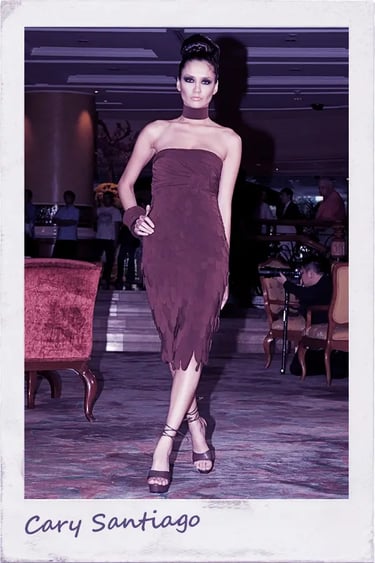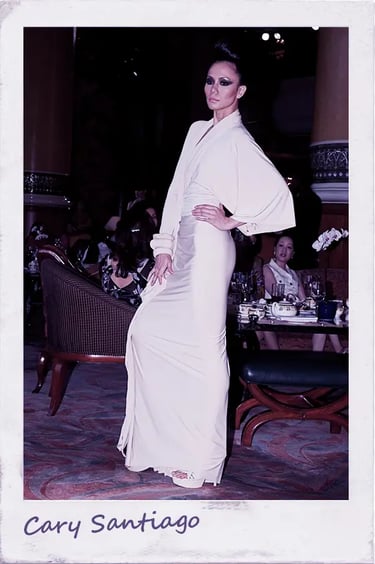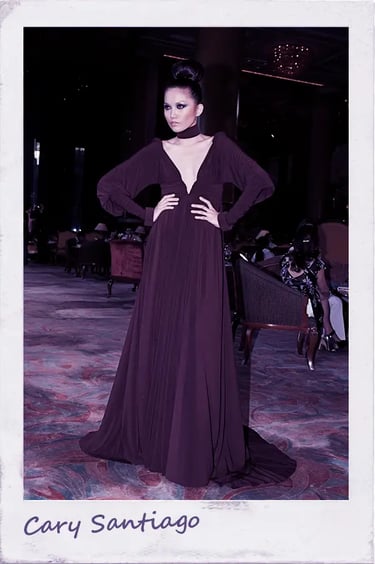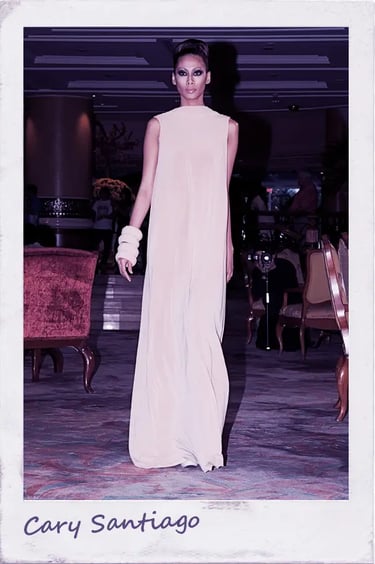Cary Santiago

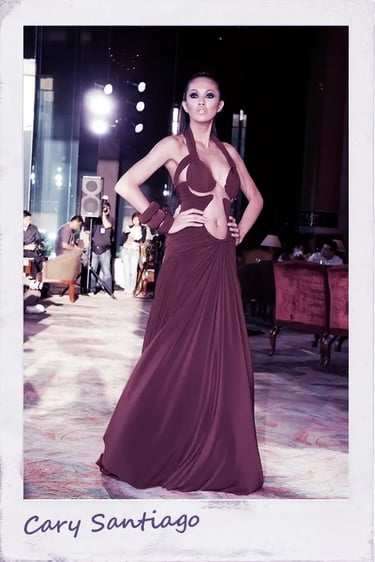

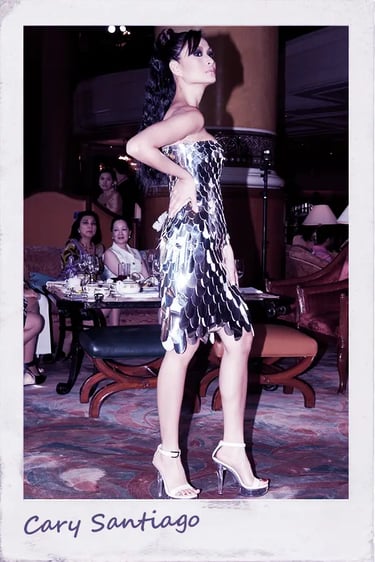

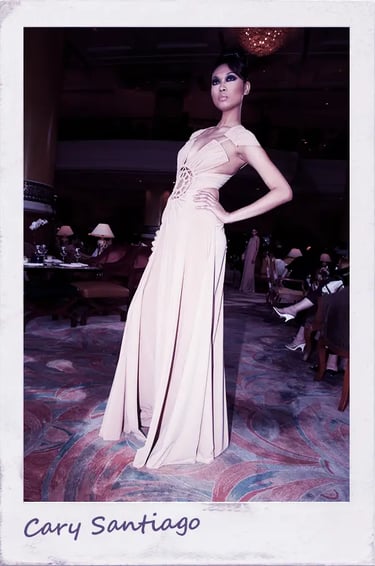

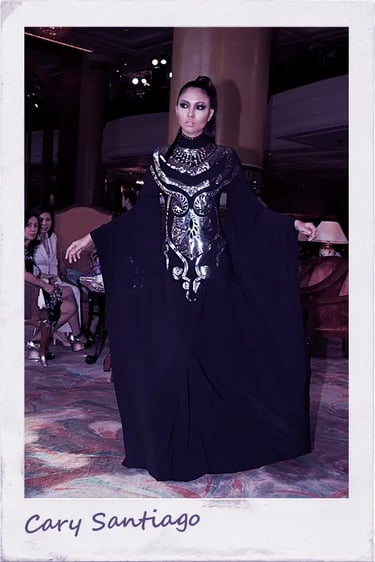

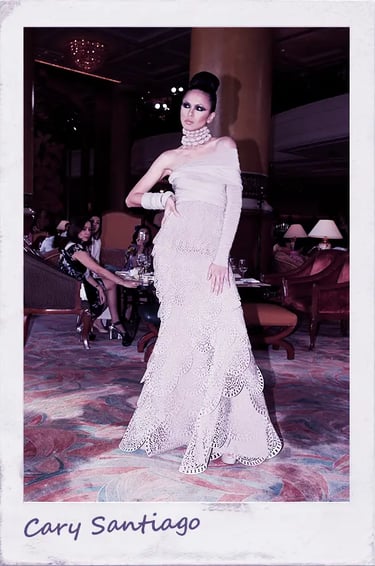

WHEN THE GREAT BECOMES DIVINE



4 March 2008

o understand the current work of Cary Santiago, one must comprehend those of his kindred brethren: Azzedine Alaia, who painstakingly studied Madeleine Vionnet (mistress of the bias cut), who immensely influenced Madame Gres (whom Santiago seemed to share the same feel for material and movement).
T
Both female couture greats favored the languid fluidity and elaborate draping that recalled classical Greek robes, while Alaia (“an artistic dressmaker of the highest quality”), Santiago may have imbibed his working philosophy from: “making a goddess out of every woman,” as the book Fashion: the Century of the Designer by Charlotte Seeling (a gift from the great Auggie Cordero), sums up the Tunisian technician.
The blockbuster collection was inspired by Homer’s Odyssey, especially the warrior goddesses Athena and Penelope. Santiago used jersey in deep mahogany, taupe, black, beige and chocolate. Why the somber shades? “These have always been my colors. Dark. They reflect my personality. I’ve never been colorful, though I don’t have a dark personality,” he says quite paradoxically, at the Rizal Ballroom where I staked him as he busily folded his beautiful frocks on one large suitcase after the show.
During the show, the gorgeous jersey falls, swirls, clings, drapes and winds down the body as if Santiago, much like Alaia, sculpted the clothes on the models himself. Chunky bangles (his ode to Jean-Paul Gaultier), shoes and oversized neckpieces were wrapped in the same hue and material as the gowns, adding to the elegant effect.
In some seductive dresses, he placed strategic peek-a-boo macramé details on the hip, groin and bosom parts; shiny silver paillette cutouts (like those worn by Phoemela Baranda and Marina Benipayo); attractive scales on a cocktail dress (on Ornussa Cadness); and the stupendous doily skirt (worn by Joy Caralde). “I am introducing doilies to jersey dresses,” Santiago says of his latest innovation.
As the finale to the first part of the Fashion Watch Quartet held at high tea at the Lobby Lounge of the Makati Shangri-La, presented by Nokia (Connecting People) and Metrobank Femme Visa with Belo Essentials and Globe Asiatique, Santiago fulfilled a fashion promise glimpsed a few years back when he won the top prize at the Fashion and Design Council-sponsored terno competition to search for the country’s representative to the now-defunct Concours de Jeunes Creaturs de Mode in Paris.
Back then, Santiago was in one of his intermittent trips back home from his base in Beirut, Lebanon, where for nearly 10 years “I am a ghost designer whereas here, I’m in the spotlight.” Following the media frenzy that came after his triumph and the ensuing curiosity about his unique (and unequaled) craftsmanship like ingenuous cuts achieved by laser, he was persuaded to showcase his astonishing talent at a Metrowear show (where he remembered having goose bumps when the audience gave him a standing ovation), at Philippine Fashion Week (where he set the bar so high at the start of Grand Allure night that others who followed him played second fiddle) and again at another Metrowear series.
“My setting up shop in Cebu was really accidental,” the sharp-tongued, tempestuous designer says in a stubborn Cebuano accent fused with French inflections, Lebanon being a former colony of France. It seemed inevitable that he cater to a local clientele so enamored of his clothes. “But I could never give up Beirut. I love Beirut. I love being alone there,” meaning the anonymity and being away from all the intrigues and innuendoes of the local fashion mill. “In Beirut, I am behind the scenes. I just want my life to be simple.”
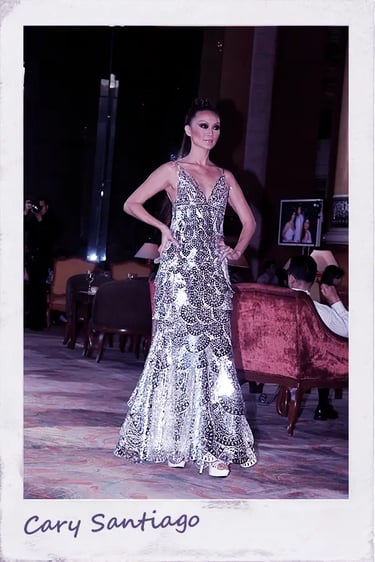

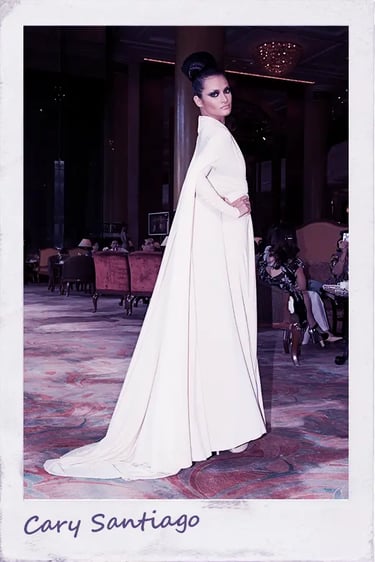

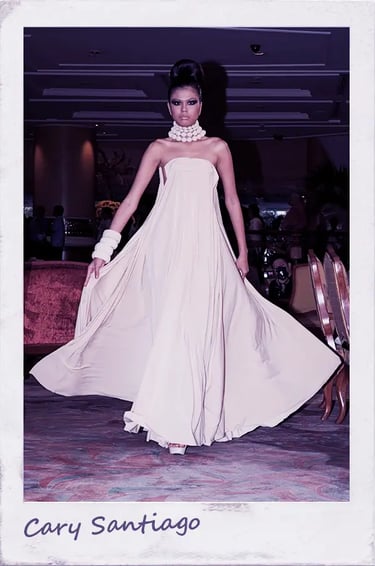

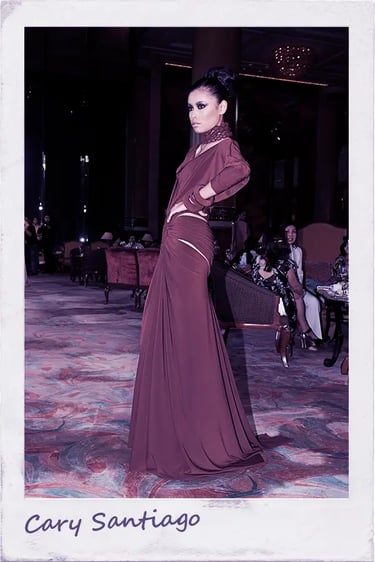

CLICK the photo to view the FULL image.

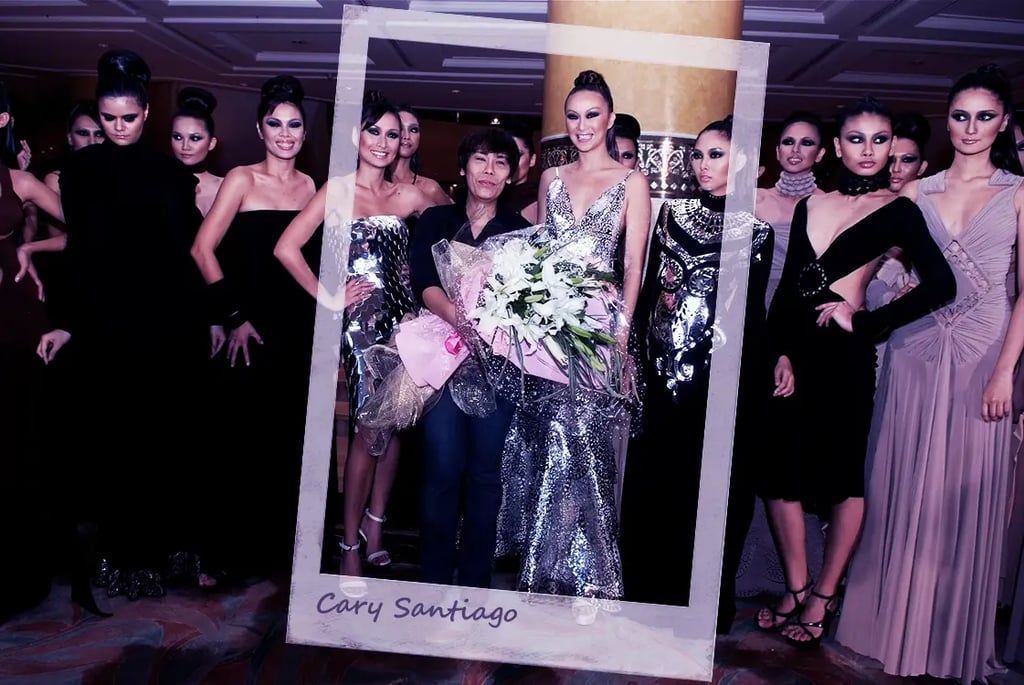

Designers comprised the Thursday crowd. “Word got around of Cary’s collection,” Barge Ramos shares, expressing amazement at Santiago’s payette-festooned pieces. “Cary has excellent technique,” opines Anthony Nocom. From senior stars Cesar Gaupo, Mike de al Rosa, Alex Bitong, Edgar Madamba and Lulu Tan Gan, to Patrice Ramos Diaz, Avel Bacudio, Jun Escario and Oj Hofer, to upstarts Jon Paras and VJ Floresca, designers were there to ascertain what all the shouting was about. Was it a fashion epiphany?
Santiago was heartened that designers whom he has admired came to watch his show. “Ito ‘yung mga taong tinitingala ko---Cesar, Mike and Inno. I joined Fashion Watch because of Inno,” the creative consultant for the series. He then recalled a time when there was also a series of shows at the Cebu City Waterfront Hotel where he met one fashion legend. “So, you are Santiago de Manila,” Cary said to Ernest. “I am Santiago de Cebu.” The duo cracked with laughter at the encounter, with Ernest having the last say: “Ganyan tayo mga Santiago! Mga patroness sa lugar natin!”
What would be misconstrued as arrogance is really an aloofness that prefers the provincial life over the pretentiousness so common among the metro’s fashion flock. “I’m really not a friendly person. It doesn’t mean that I choose friends, it’s just that [I don’t easily warm up to people]. If we meet and we click, then maybe we could become friends,” Santiago explains, while nibbling on a salmon head.
He admits to being quite snobbish when it comes to accepting new orders. “I won’t accommodate clients if I don’t feel like it. I am the one who does the cutting so I’m afraid if I accept too much, the quality of the clothes might suffer,” he explains. This is also the reason why his non-Cebu clients like him where he is based. “They like the exclusivity,” the inaccessibility and the pride that they ordered their dresses from Cebu.
But Manila will soon get a taste of that Cary Santiago mystique when he comes back for a show sometime later this year. “I am ready for a gala,” the wunderkind says, but withheld any further information. One thing for sure, he doesn’t want any of the hitches and the headaches, which are common in staging a fashion show, to happen again like what ensued at his Shang show.
A mere two hours before his scheduled showing, Santiago was still imploring the organizers to provide him with three new models who can properly fit his complex, body-skimming gowns, to complete his 25-piece collection. After much tension and harsh words exchanged, Santiago ended up paying for the three new ones besides the five that he specifically wanted for his show.
A designer, after all, has to spend his own money (besides the honorarium) so that his vision will be fully realized. “Did I lose out? I don’t think I did. I got who I wanted,” Santiago, steely as he is, says. “I know how it is to stage fashion shows. In Beirut, I do collections four times a year, one for each season.”
If he does so with that frequency here, we will then know the secret to his technical wizardry and appreciate more the hands-on personalized attention to every piece of garment.
Will the art of couture, a term so abused and loosely applied in this country, ever reach a higher standard?
That’s nearly impossible here, as designers are as adulated as the women that they dress and stylize. “I don’t have any aspirations to be part of high society, though I dress up women who belong there. I am not easily impressed by anyone, no matter who they are. But I know how to position myself and I know where I come from,” Santiago says, sharing that he is perfectly content to be in rugged clothes eating Spanish bread, sticky rice delicacies and tsokolate outside his Cebu shop than be in a society soiree.
Be that as it may, Santiago, however tired, gladly accommodates the women who lunch especially when they come unannounced. As we were seated for an informal interview, a group of foreign-looking women came up to the ballroom to see him. They turned out to be Lizzie Zobel, Barbara Aboitiz, Pamen Elizalde, Melissa Osmeña Aboitiz Elizalde and their French friends. They came to buy the clothes outright.
But Santiago couldn’t sell them the dresses that they have coveted from the show. The clothes have to be flown to Beirut to be part of the collection of the couture house that he works for. Zobel was endearingly adamant, and could she wear the gown that Raya Mananquil modeled? It was her husband Fernando’s birthday party that night and she wanted to look her smashing best.
Santiago was firm. He will fly back to Manila to fit the ladies, just as he usually does for his clients in the capital such as Cristina and Katrina Ponce Enrile, and Via Hoffman, one of his “Ultimates,” a client who is shown 10 dresses and will buy nine. In Cebu, he dresses up Mariquita Yeung, Amparito Lhuillier, Gov. Gwen Garcia, the Aboitizes and the Osmeñas, with fashion plate Minnie on his appointment books.
A model-type herself, the Colombian beauty Zobel had to content herself with fitting a drapey gown that’s rather complicated to put on. “Liz, are you OK?” a friend asked when she disappeared behind a panel that served as a makeshift dressing room. “Cary’s helping me. I wouldn’t have figured this out. Promise!” Zobel replied. When she came out, there were girly cries of “that’s very nice!”
As the other ladies tried on the ultra-revealing gowns, some with gravity-defying plunges at the front and back, which Santiago will have to tweak for decent adjustments, Zobel tried on the tube dress that Ornussa modeled. They all agreed that the dress became Lizzie. At his Cebu shop, Santiago has mannequins made to the exact measurements of his regular clients, so that when the time comes to fit “it is 99.9 percent perfect, except when I have to cut the length of the dress until you wear the right shoes. Or maybe the bust line, an inch or two.”
After the ladies fluttered like the social philanthropists that they are, Santiago and his “assistants” that day, fellow designers and Concours finalists Angelo Estera and Ray Kuan, packed all the things used for the show and debated where to eat. Since they arrived in Manila, all that they’ve consumed were burgers from McDonald’s and they wanted to eat some real good food. Tagging along, I went with the rowdy bunch to Greenbelt 5, finally settling on the Asian offerings of Fely J’s.
Seated on a dim corner of the al-fresco dining area overlooking the Greenbelt chapel, having ordered an emperor’s feast of salmon head soup, callos, crispy pata and rice, Santiago continued with his personal assessment of his successful conquest of Manila’s fashion cognoscenti. The crowd on Tuesday was composed mostly of the press, society women and Southern donas who flew in to support Santiago.

